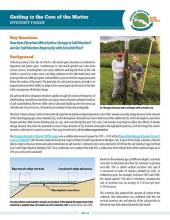
Blue carbon storage - carbon sequestration in coastal wetlands - can help coastal managers and policymakers achieve broader wetlands management, restoration, and conservation goals, in part by securing payment for carbon credits. To help bring wetland restoration projects to market, the Waquoit Bay National Estuarine Research Reserve led a collaborative project to build capacity to integrate blue carbon into management decisions by creating tools to quantify greenhouse gas fluxes and carbon storage in restored marsh. As part of this project, the team developed high school STEM curriculum resources on the relationship between climate change impacts and carbon storage in New England salt marsh.
About this resource
Bringing Wetlands to Market high school STEM curriculum module - This curriculum examines the relationship between salt marsh, climate change, nitrogen pollution, and the economic value of salt marshes as carbon sinks. The curriculum, developed as part of an earlier phase of the Bringing Wetlands to Market project, is part of a larger collection of resources for teachers, and was updated in the second phase of the project.
Salt Marsh Carbon Storage and Modeling lesson plans - In these lessons, aligned to the Next Generation Science Standards, students analyze real-world data from New England salt marshes and explore the relationship between climate impacts and salt marsh carbon storage.
| Getting to the Core of the Matter | Student handout |
| Teacher lesson plan | |
| Modeling Blue Carbon in Salt Marshes | Student handout |
| Teacher lesson plan |